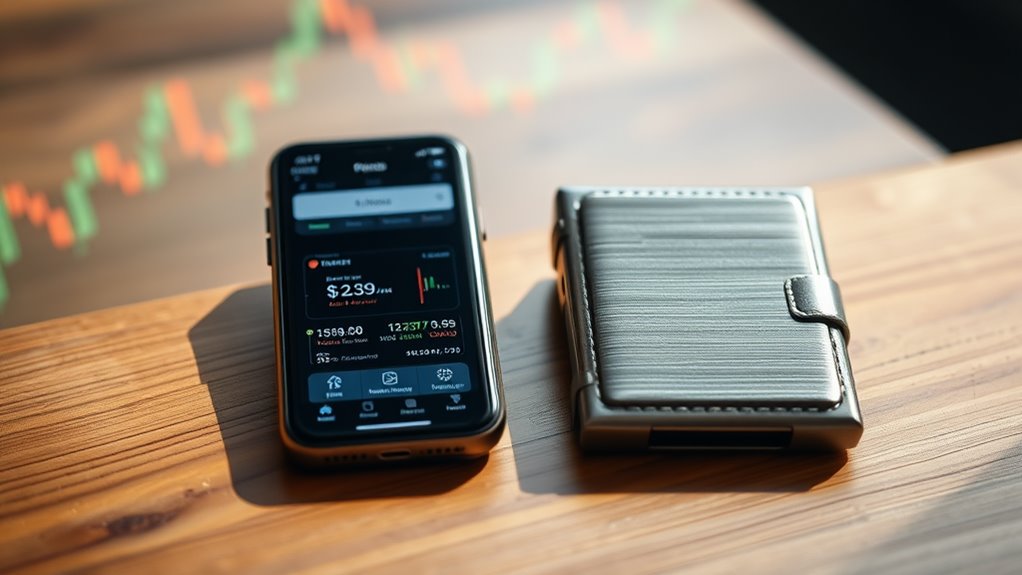
Hot Vs Cold Wallets: Which Is Right for You?
When choosing between hot and cold wallets, individuals must consider their needs for security and accessibility. Hot wallets, connected to the internet, offer quick access for frequent transactions but are more susceptible to cyber threats. In contrast, cold wallets store private keys offline, providing enhanced security for long-term investments. Each type has associated costs and security features that vary. Understanding these differences can help users make informed decisions based on their specific situations and financial goals. More insights are available on this topic.
Key Takeaways
- Hot wallets are ideal for frequent transactions due to their convenience and quick access to funds.
- Cold wallets provide enhanced security, making them suitable for long-term investments and significant holdings.
- Consider your trading habits; hot wallets are best for small, regular transactions, while cold wallets are better for large, infrequent trades.
- Weigh the costs: hot wallets are typically free but incur ongoing maintenance, while cold wallets have initial purchase costs but lower long-term risks.
- Employ best practices, like using strong passwords and two-factor authentication, regardless of wallet type, to maximize security.
Understanding Crypto Wallets

Crypto wallets serve as critical tools for managing digital currencies, enabling users to store, send, and receive cryptocurrencies like Bitcoin.
These wallets come in two main types: custodial and non-custodial. Custodial wallets are managed by third parties, while non-custodial wallets provide users complete control over their private keys.
Crypto wallets are categorized into custodial and non-custodial, with the latter granting users full control over their private keys.
Additionally, wallets can be categorized as hot or cold. Hot wallets are connected to the internet, allowing for quick transactions but posing higher security risks. Conversely, cold wallets are offline, offering enhanced security for long-term storage.
The choice between hot and cold wallets depends on individual needs for convenience versus security, making it crucial for users to understand these distinctions before selecting the appropriate wallet for their cryptocurrency management. Furthermore, selecting the right wallet involves considering the security level necessary for protecting your assets.
The Importance of Security in Wallets

Selecting the right wallet for managing cryptocurrencies involves not only understanding the differences between hot and cold wallets but also recognizing the importance of security in safeguarding digital assets.
Hot wallets, while convenient for everyday transactions, are susceptible to online threats such as malware and phishing attacks due to their constant internet connection. In contrast, cold wallets provide enhanced security by keeping private keys offline, reducing exposure to potential hacking attempts and smart contract scams.
They often incorporate advanced security features like Secure Element chips, biometric authentication, and tamper-evident designs. Users must carefully consider their security needs against their trading habits, as cold wallets are more suitable for long-term storage, while hot wallets may appeal to those seeking ease of access. Additionally, employing strong, unique passwords is essential to further protect your digital assets.
Hot Wallets: Features and Benefits

Hot wallets are an essential tool for cryptocurrency users, offering a range of features that enhance accessibility and convenience.
These wallets provide constant access to cryptocurrencies, allowing users to manage their assets from anywhere with an internet connection. They are designed for quick transactions, making them ideal for frequent trading activities.
User-friendly interfaces cater to newcomers, ensuring ease of use. Hot wallets come in various forms, including software, web, and mobile wallets, as well as exchange wallets, providing flexibility based on individual preferences.
User-friendly interfaces make hot wallets accessible, with various forms like software, web, and mobile options for every user preference.
Additionally, many hot wallets integrate seamlessly with cryptocurrency exchanges, simplifying the trading process. Overall, the convenience and real-time access make hot wallets a popular choice for active cryptocurrency users. Furthermore, hot wallets are essential for securely managing access to digital assets on the blockchain.
Cold Wallets: Features and Advantages

Cold wallets serve as a counterbalance to the accessibility of hot wallets, offering a distinct set of features and advantages tailored for users prioritizing security. These wallets store private keys offline, considerably reducing the risk of hacking and malware. They often include physical security measures, such as PIN codes and self-destruct mechanisms. Additionally, cold wallets facilitate multi-account management, and many come with recovery mechanisms like seed phrases. Furthermore, using a cold wallet can significantly enhance the power of hardware wallets, ensuring your cryptocurrency assets remain safe from online threats.
| Feature | Advantage |
|---|---|
| Offline Storage | Protects against online threats |
| Physical Security | Enhances protection from unauthorized access |
| Multi-Account Management | Allows diverse asset organization |
| Recovery Mechanisms | Safeguards against loss or damage |
Comparing Security Risks of Hot and Cold Wallets

When comparing the security risks associated with hot and cold wallets, it is essential to recognize the fundamental differences in their operational environments.
Hot wallets, which are connected to the internet, are more vulnerable to online threats like hacking, phishing, and malware. These risks arise from their constant exposure to cybercriminals seeking unauthorized access.
In contrast, cold wallets remain offline, greatly reducing their susceptibility to such online attacks. However, they are not without risks, as they can be subject to physical loss or theft. Additionally, users should consider implementing two-factor authentication (2FA) to enhance security, especially when using hot wallets.
Convenience Factors: Hot Vs Cold Wallets

The choice between hot and cold wallets greatly impacts the convenience of managing cryptocurrencies.
Hot wallets are always online, allowing users to access their funds at any time. This feature enables instant transactions, making them ideal for active traders and those who frequently buy or sell cryptocurrencies. Additionally, hot wallets can be accessed from multiple devices, enhancing flexibility and usability. Their user-friendly interfaces cater to novice users, while integration with decentralized applications (dApps) streamlines various services. Furthermore, hot wallets store private keys, which are crucial for accessing cryptocurrency stored on the blockchain, but this connection to the internet increases exposure to security risks.
In contrast, cold wallets, being offline, require more steps for transactions, making them less convenient for regular use. They are best suited for long-term storage, highlighting the importance of choosing the right wallet based on individual needs and trading habits.
Cost Considerations for Wallet Types

When considering the costs associated with hot and cold wallets, several key factors come into play.
Initial setup expenses can vary considerably, with hot wallets often being free, while cold wallets require a purchase of hardware.
Additionally, ongoing maintenance costs and long-term investment value must be evaluated, as these factors influence the overall financial implications for users. For instance, cold storage security provided by devices like the Ledger Nano X can justify the initial expense for users focused on long-term holding.
Initial Setup Expenses
In many cases, the initial setup expenses for cryptocurrency wallets can markedly vary between hot and cold wallets, reflecting their different functionalities and security measures.
Hot wallets, designed for ease of access, typically range from $15,000 to $35,000 for basic versions, while advanced options can escalate to $300,000.
Cold wallets, focused on security, start at $40,000 and can reach up to $100,000, with custom development further increasing costs.
Users should consider these factors:
- Security features, like encryption and multi-factor authentication
- Development costs for user-friendly interfaces
- Integration for real-time blockchain syncing
- Manufacturing expenses for hardware wallets
Additionally, it’s important to evaluate the staking rewards that different wallet types may offer, as this can significantly influence your overall investment strategy.
Understanding these initial expenses helps individuals determine the most suitable wallet type for their needs and budget.
Ongoing Maintenance Costs
Ongoing maintenance costs for cryptocurrency wallets can considerably impact overall expenses, as they vary based on the wallet’s type and complexity.
Hot wallets typically incur higher ongoing costs due to the need for frequent software updates, robust online security measures, and regular vulnerability patches. These wallets may benefit from user-friendly interfaces, which reduce technical support needs.
In contrast, cold wallets face different expenses, including occasional hardware upgrades and maintaining offline security measures.
Additionally, both wallet types may need to invest in compliance updates and customer support, which can further increase costs. Understanding these ongoing expenses is essential for users to make informed decisions about their cryptocurrency wallet options. Moreover, non-custodial wallets generally provide better security by allowing users to control their own private keys, reducing risks associated with third-party management.
Long-Term Investment Value
The long-term investment value of cryptocurrency wallets hinges on various cost considerations that users must evaluate carefully.
Users should consider the associated costs of different wallet types to make informed decisions about their investments.
- Initial Setup Costs: Hot wallets are typically free, while cold wallets require hardware purchases ranging from $50 to $250.
- Security Features: Cold wallets offer enhanced security by storing keys offline, making them suitable for significant investments.
- Risk Factors: Cold wallets may lead to irrecoverable loss if the device fails without a backup.
- Convenience vs. Security: While hot wallets provide quick access for transactions, they expose funds to higher risks of cyber threats.
Additionally, users must ensure they securely store their seed phrases to prevent unauthorized access and potential loss of funds.
Evaluating these factors is essential for determining which wallet type aligns with long-term investment goals.
Choosing the Right Wallet Based on Usage Scenarios

Choosing the right wallet for cryptocurrency depends on specific usage scenarios, such as daily transaction needs and long-term storage strategies.
Hot wallets offer convenience for regular transactions, making them suitable for users who frequently trade or need quick access to funds.
In contrast, cold wallets provide enhanced security for larger holdings and are ideal for individuals focused on long-term investment, minimizing the risk of cyber threats.
Daily Transactions Needs
When deciding how to manage daily transactions in the world of cryptocurrency, understanding the differences between hot and cold wallets is essential.
Hot wallets, connected to the internet, are designed for quick and frequent transactions, making them suitable for everyday use. In contrast, cold wallets, which are offline, require additional steps for transactions, posing challenges for regular users.
- Hot wallets are ideal for small balances used in daily transactions.
- Businesses typically allocate 5% of funds to hot wallets for operational efficiency.
- Cold wallets offer enhanced security but are inconvenient for frequent access.
- Implementing two-factor authentication can improve the security of hot wallets.
Choosing the right wallet hinges on balancing transaction speed and security needs.
Long-term Storage Strategy
While selecting a wallet for long-term storage, it is essential to evaluate how the choice aligns with individual usage scenarios and security needs.
Cold wallets, such as hardware devices and paper wallets, provide high security since they are not connected to the internet. This reduces the risk of hacking, making them ideal for safeguarding significant amounts of cryptocurrency. However, users must consider the potential for physical loss or damage.
Additionally, regular updates are necessary to maintain security. A combination of hot and cold wallets can balance convenience and safety.
Ultimately, understanding market volatility and diversification strategies is vital for long-term asset management and minimizing risk.
Best Practices for Wallet Security

Ensuring wallet security is essential for anyone involved in cryptocurrency transactions.
To protect assets effectively, users should adopt several best practices for wallet security.
- Choose a Wallet with Strong Security Features: Look for encryption and two-factor authentication.
- Download from Official Sources: Always obtain software wallets from official websites to minimize malware risks.
- Use Complex Passwords: Create a strong password that combines letters, numbers, and symbols for added protection.
- Regularly Update Software: Keep wallet software current to benefit from important security patches.
Strategic Use of Hot and Cold Wallets

The strategic use of hot and cold wallets is essential for cryptocurrency users seeking to balance convenience and security.
Hot wallets, which are software-based and connected to the internet, are ideal for frequent transactions due to their accessibility. However, they pose security risks, making them unsuitable for holding large amounts of cryptocurrency.
Hot wallets offer convenience for frequent transactions but come with security risks, making them unfit for storing large cryptocurrency amounts.
On the other hand, cold wallets, being hardware-based and offline, provide enhanced security for long-term storage, protecting private keys from online threats.
A combined approach allows users to utilize hot wallets for smaller, everyday transactions while reserving cold wallets for substantial holdings.
This strategy minimizes exposure to potential hacks and optimizes portfolio management, ensuring that users can benefit from both ease and security in their cryptocurrency dealings.
Frequently Asked Questions
Can I Switch Between Hot and Cold Wallets Easily?
Switching between hot and cold wallets is feasible, though it requires careful execution. Users must connect cold wallets to a device, ensuring compatibility and security, while minimizing exposure to online threats during the transfer process.
How Do I Recover a Lost Cold Wallet?
To recover a lost cold wallet, one must utilize the seed phrase, download compatible software, and select the restore option. Keeping backups secure and updated greatly enhances the chances of successful recovery.
Are Hot Wallets Safe for Large Investments?
Studies indicate that over 60% of cryptocurrency thefts occur through online wallets. For large investments, hot wallets pose significant risks due to vulnerabilities, making them less suitable compared to more secure offline storage options.
What Happens if My Hot Wallet Provider Goes Offline?
If a hot wallet provider goes offline, users may face difficulties accessing their funds. Recovery relies on private key management and backup procedures, while service outages can hinder asset retrieval and lead to potential financial loss.
Can I Use Multiple Hot Wallets Simultaneously?
Using multiple hot wallets simultaneously is feasible. It allows for transaction flexibility and risk distribution. However, it also introduces management complexity and increases security risks, necessitating diligent monitoring and robust security measures for each wallet.
Conclusion
To sum up, selecting between hot and cold wallets requires careful consideration of security, cost, and usage preferences. Hot wallets offer convenience and quick access, while cold wallets provide enhanced safety for long-term storage. By balancing benefits with potential risks, users can effectively safeguard their digital assets. Ultimately, a strategic combination of these wallet types may serve as the smartest solution, ensuring both accessibility and protection in the ever-evolving cryptocurrency landscape.












